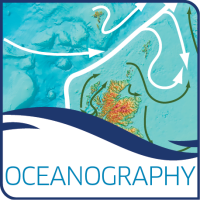Seasonal mean physical variables from the FVCOM Scottish Shelf Model (SSM) interpolated to 1.5 x 1.5 km and 7 x 7 km regular grids. The data are averaged over 3x four month periods (MAMJ, JASO, NDJF), and are provided from model runs with and without large scale tidal energy extraction (10x tidal stream arrays, EcoWatt2050) included.
Variables: sea bottom temperature (BT), potential energy anomaly (PEA), and largest 95 percentile of instantaneous depth-averaged current speed (p95).
These data are from a 1 year climatological model run of the SSM (version 2.02) representing 2038-2062.
Naming convention:
MAMJ: March, April, May, June
JASO: July, August, September, October
NDJF: November, December, January, February
These data were developed under the EcoWatt2050 EPSRC projects (grant numbers EP/J010170/1 & EP/K012851/1 respectively) using the Scottish Shelf Model (http://marine.gov.scot/themes/scottish-shelf-model). For more information about EcoWatt2050 please see http://marine.gov.scot/information/EcoWatt2050.
Data and Resources
- SSM_variables_2038-2062_climatology_2.02_1.5km_regular_gridnetCDF
netcdf SSM_variables_2038-2062_climatology_2.02_1.5km_regular_grid {
Download
... - SSM_variables_2038-2062_climatology_2.02_7km_regular_gridnetCDF
netcdf SSM_variables_2038-2062_climatology_2.02_7km_regular_grid {
Download
...
| Field | Value |
|---|---|
| Publisher | |
| Modified | 2020-01-07 |
| Release Date | 2019-05-15 |
| Identifier | 5518d357-82d2-42cb-a974-15fd6ed015d7 |
| Spatial / Geographical Coverage Area | POLYGON ((-12.568359375 47.706065135696, -12.568359375 61.404607304341, 11.689453125 61.404607304341, 11.689453125 47.706065135696)) |
| Temporal Coverage | 2038-01-01 to 2062-12-31 |
| Language | English (United Kingdom) |
| License | UK Open Government Licence (OGL) |
| Granularity | Averaged over 4 month periods |
| Data Dictionary | The future climate forcing for the 2038-2062 climatological model run was derived from one single projection (one single model and one future emission scenario): the Hadgem2-ES forced by the RCP8.5 scenario. HadGEM2-ES (The HadGEM2 Development Team, 2011) is a coupled Earth System Model that was used by the Met Office Hadley Centre for the CMIP5 simulations. The future climate forcing (atmospheric and boundaries) was calculated using a delta-change approach, i.e. by perturbing the present forcing with a multiplicative or an additive correction, that is a function of the future climate change forcing (based on Hadgem2) in relation to its present day control (based on ERA-Interim data, Dee et al. 2011). The river runoff volume fluxes were not perturbed. A climatology for 1962-2011 was used, and this was obtained from the Centre for Ecology and Hydrology (CEH) Grid-to-Grid (G2G) model (Bell et al. 2007, Cole and Moore 2009). For a full description of these data see De Dominicis et al. (2018). V. Bell, A. Kay, R. Jones, R. Moore, 2007. Development of a high resolution grid-based river flow model for use with regional climate model output, Hydrol. Earth Syst. Sci. 11 (1) 532-549. S.J. Cole, R.J. Moore, 2009. Distributed hydrological modelling using weather radar in gauged and ungauged basins, Adv. Water Resour. 32 (7) 1107-1120. De Dominicis, M., Wolf, J., & O’Hara Murray, R. B., 2018. Comparative effects of climate change and tidal stream energy extraction in a shelf sea. Journal of Geophysical Research-Oceans. https://doi.org/10.1029/2018jc013832 D.P. Dee, S.M. Uppala, A.J. Simmons, P. Berrisford, P. Poli, S. Kobayashi, K. Edwards, R. Barciela, M. Butenschon, 2012. Validation of the NEMO-ERSEM operational ecosystem model for the North West European continental shelf, Ocean Sci. 8 983-1000. E. O'Dea, A. Arnold, K. Edwards, R. Furner, P. Hyder, M. Martin, J. Siddorn, D. Storkey, J. While, J. Holt, H. Liu, 2012. An operational ocean forecast system incorporating NEMO and SST data assimilation for the tidally driven European North-West shelf, J. Oper. Oceanogr. 5 (1) 3-17. J. Wolf, N. Yates, A. Brereton, H. Buckland, M. De Dominicis, A. Gallego, R. O’Hara Murray, 2016. The Scottish Shelf Model. Part 1: Shelf-Wide Domain. Scottish Marine and Freshwater Science Vol 7 No 3, 151pp. doi: 10.7489/1692-1 The HadGEM2 Development Team: G. M. Martin, Bellouin, N., Collins, W. J., Culverwell, I. D., Halloran, P. R., Hardiman, S. C., Hinton, T. J., Jones, C. D., McDonald, R. E., McLaren, A. J., O'Connor, F. M., Roberts, M. J., Rodriguez, J. M., Woodward, S., Best, M. J., Brooks, M. E., Brown, A. R., Butchart, N., Dearden, C., Derbyshire, S. H., Dharssi, I., Doutriaux-Boucher, M., Edwards, J. M., Falloon, P. D., Gedney, N., Gray, L. J., Hewitt, H. T., Hobson, M., Huddleston, M. R., Hughes, J., Ineson, S., Ingram, W. J., James, P. M., Johns, T. C., Johnson, C. E., Jones, A., Jones, C. P., Joshi, M. M., Keen, A. B., Liddicoat, S., Lock, A. P., Maidens, A. V., Manners, J. C., Milton, S. F., Rae, J. G. L., Ridley, J. K., Sellar, A., Senior, C. A., Totterdell, I. J., Verhoef, A., Vidale, P. L., and Wiltshire, A., “The HadGEM2 family of Met Office Unified Model climate configurations,” Geoscientific Model Development, 4, 723-757, 2011. |
| Contact Name | Marine Scotland |
| Contact Email | |
| Public Access Level | Public |


